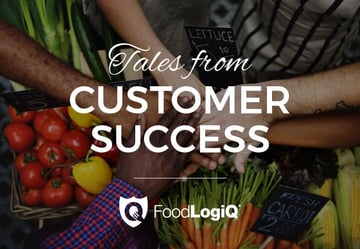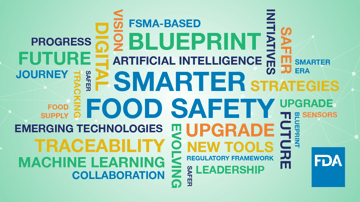Food industry trends are changing fast—sometimes faster than what you and your supply chain can keep up with. From the customer demand for transparency to the FDA’s mandate for better processes, traceability is no longer just a nice-to-have asset. Without this sort of insight, keeping up with the evolving industry will be highly problematic, if not impossible.
Data is your key to better visibility into the supply chain, stronger processes, reduced food safety risks and more consumer engagement. In short, having access to this information can revolutionize your business.
To learn more about the power of data, how professionals like you can use this information and the state of the industry overall, we sat down with Senior Director of Global Industry Development at 1WorldSync, Nick Manzo.
Could you just give us a little bit of background on 1WorldSync?
We are a data support and data delivery mechanism for supply-side and recipient-side organizations. The common way we describe ourselves is similar to Netflix—we're a content delivery platform. We don't own the content, but we deliver it. Whether you're someone who provides content or someone who wants to view and consume content, we deliver it back and forth. 1WorldSync is the largest organization that shares the most amount of product information using the GDSN methodology at a global level.
What exactly is GDSN?
One of the ways in which we deliver content is through a very structured and organized process called GDSN®, or the Global Data Synchronization Network™. GDSN has predefined, global rules of engagement created by GS1®. And GS1 is the governing body that owns and operates the use of this system of standards (also referred to as the G10 or GLN, which used to be known as the UPC, the Universal Product Code).
All the barcodes you see on retail-based products is a GS1 U.S.-governed barcoding system. It looks at things in three tiers: identify the product using the system of standards, capture the information using scanning methodologies such as barcodes, and share the information through GDSN.
Let's say I'm a food safety professional. Can you walk me through an example of how I might use the GS1 process for a specific product?
In food safety, you’re heavily reliant on some type of system of standards to reduce supply chain costs. You don't want your staff scan something that’s not globally harmonized between you, as a food safety professional at a restaurant, the manufacturer and the distributor. Imagine if the manufacturer and the distributor each put their own number on the product. Then, when the product reached the operator, they decide to stick their own label on it, too. What if there is a recall? Without a universal system, how would you know from where it originated?
With GS1, there's a single item identifier, a single barcode or number on a product that you can scan to see the history of that product: where it originated, core information about the product, where it was dropped off, where it was scanned again and how it reached you.
FSMA and consumer demands mean food industry professionals are starting to require better data and traceability. What would you say are the top two or three key benefits of having traceability connected to a database?
For so many years the focus was always on, "How do we manufacture it, distribute it and sell it?" But over the past five years there's been a shift—and I'd say it's directly related to the advance in technology, predominantly mobile use—that has driven the need to have transparency and visibility around all the information relative to a product. And organizations are realizing that they have to spend time, energy, effort and dollars to ensure their internal systems support all of this information.
Now there’s enormous emphasis on understanding product data management strategies. Questions like: How much information do they need? Where is it coming from? Is it standardized? Is it of quality? Is it building a foundational base that we can apply to new programs?
Let's say a consumer walks into a restaurant and uses an app to scan and find out all the nutritional information about a meal. The scan has to go back to an item identifier that leads to all other attributes: serving size, nutritionals and allergens. The information starts at the manufacturer, then it’s delivered to the distribution unit and the operator.
You just mentioned one of the ways food retailers can use this data. What are some other innovative ways that restaurants, grocery stores and other retailers could use this information?
Consumers go to restaurants and shop at grocery stores, but the experience is vastly different.
In a foodservice industry setting, there has always been a challenge with providing transparency for products with multiple ingredients. It takes an enormous amount of organizational understanding of product information to support the delivery of that data in a way that’s easily accessible for a customer. The fact of the matter is, by 2020, 80% of the world’s population will have some form of smartphone. The industry needs to be prepared to provide information to these devices.
Grocery stores have packages that include a base set of information. If the consumer has the ability to scan that package, they can obtain even more data for the product.
GMA and FMI started an initiative called SmartLabel, which allows consumers access to a standardized page of information that contains nutritional, allergen, ingredient and dietary claims on all products. That initiative will help the foodservice industry find innovative, new ways to engage.
Another big trend is localization—providing better awareness of how far a product has traveled in order to deliver it to me, the consumer. If I know a product was delivered fresh from a farm 20 miles away, it'll make me feel better about consuming it, versus shrimp that was farm-raised in Taiwan. I may be willing to pay an extra dollar for a local product because it makes me feel better knowing I'm eating something grown in the U.S.
Recently, there have been some startling DNA tests that showed the ingredients of certain foods were not what the brand claimed. Do you think access to data could curb this food fraud?
The question is, how far will the consumer take the necessity to have transparency? How much will that drive change? The proclivity for access to information will support innovative organizations to look at ways to provide access to information that drives consumers into their establishments and keep them engaged.
Take, for example, the availability of online menus. You can now peruse a menu before you go to a restaurant to see if it's something you like, caloric counts, dietary information and allergens. The natural evolution is the ability to find more information about the farm from where a restaurant’s beef was raised, for example. Maybe the establishment claims all its produce was locally grown by farms within a 15-mile radius, and is able to list the exact farms from where it sourced the ingredients you’re eating. That reality is quickly approaching. The question is, are organizations building infrastructures and processes to support what consumers are going to demand?
Recalls have been happening for a very long time, and people have been aware of them for a very long time. What do you think is causing the sudden consumer demand for better transparency?
The simple answer is the Internet. The secondary answer is Google and Amazon.
Forty years ago, if there was a recall in some type of factory, it may have been on the nightly news once and then people never heard about it again. But when you're dealing with consumer safety issues today, information is being shared with millions of individuals in a multitude of ways—mobile, social—it's not going to stop. And it will always be an easily searchable public record.
When you buy products today, what’s the first thing do you do? You Google it. And the second thing you do? Go to Amazon. That's completely changed consumer behavior. The ability to search for a product, read reviews and find out attribute information before point-of-sale has skyrocketed. It’s become how you function as a consumer.
Look at the advent of Yelp as it relates to restaurants, whether or not someone actually goes into a restaurant. You make a decision based on the information you find there And the natural progression is for this practice to move onto food items.
The ability to trace and track products along your supply chain will help your organization move into the future and help you provide the experience consumers expect. Learn more in our free e-book, Selling the C-Suite on Supply Chain Traceability Software.
Tag(s):
Food Safety
Other posts you might be interested in
View All Posts
Supplier Compliance
6 min read
| August 30, 2018
Food For Thought: Meal Kits, Supply Chain, and Customer Success
Read More
Food Safety
5 min read
| December 18, 2019
A New Era of Smarter Food Safety Public Comments
Read More
Food Industry
6 min read
| October 18, 2019

